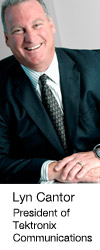Lyn Cantor, president of Tektronix Communications, talks to VanillaPlus about how the global CSP market is adapting to LTE deployment and explains how the opportunity to extract real value from the big data that CSPs generate is, at last, becoming real thanks to the tools and technologies that are now being deployed
VanillaPlus: What were the main themes and market drivers that characterised CSP focus in 2013?
 Lyn Cantor: I saw more of a mixed bag of themes and drivers in 2013 than in previous years. There have been a lot of differences with respect to LTE deployments. The pace of deployment and the market dynamics in the US have been pretty high so that has had a positive effect on the spending on and the speed of deployment of other technologies that surround or are adjacent to LTE in that market.
Lyn Cantor: I saw more of a mixed bag of themes and drivers in 2013 than in previous years. There have been a lot of differences with respect to LTE deployments. The pace of deployment and the market dynamics in the US have been pretty high so that has had a positive effect on the spending on and the speed of deployment of other technologies that surround or are adjacent to LTE in that market.
In the US we have seen aggressive spending which contrasts sharply with what we are seeing in Europe where the user demand and the regulatory environment has not driven the same uptake for LTE or a robust data services network. European appetite for LTE is starting to turn up a bit but ARPU remains much higher in the US. People are much more willing to spend – mostly on video services – and that market has not ignited yet in Europe.
In Europe we did see more spending on 3G and CSPs dipping their toes in the water on LTE but operators are being thoughtful about their timing and deployments. There doesn’t seem to be a lot of momentum for CSPs looking to achieve first mover advantage.
VP: If the Europeans are being cautious and waiting for demand to crystalise and the US has already initiated LTE, how did Asia develop in 2013?
LC: In Asia we see a hybrid of both dynamics depending on which country you’re in. Some markets, such as Japan, Australia and Singapore, have really accelerated their spending and are very active markets. However, Asia is composed of very different national markets each of which are moving at their own pace.
Overall, I’d characterise 2013 as a mixed environment in which we won new customers and brought the vast majority of our 3G customers over to LTE.
VP: How did you respond to these contrasting rates of LTE market development?
LC: We followed the customers and the spending and put our resources to work, cutting our teeth on the next one to two phases of the challenges CSPs operators are facing. By working with CSPs like AT&T, Verizon and T-Mobile in the US, we’ve gained great experience. The scale and pace of their deployments have been so great that we’ve not only been able to deploy LTE networks but other technology such as voice over LTE (VoLTE) and Diameter signaling.
The great thing for us is that we’ve dealt with the early deployments of our solutions and handled the scale of the largest CSP roll-outs. That has hardened our experience and products which will serve us well as roll-out continues.
We believe we have the most robust solutions to serve and deploy for 3G and 4G customers. The systems have integrated workflow linking customer care through the multiple technologies within the network. We’re really well prepared for the market’s timing as Europe and Asia come on line.
VP:This isn’t a voice or data world anymore. It’s a unified world of voice, video and data served to customers in a quality aware way. How has this landscape changed since the deployment of 3G?
LC: When I think about the deployment of networks, CSPs were trying to get capacity on the ground to manage voice, video and data. The first dynamic has been the rapid deployment of LTE networks. The second is that with Diameter signaling the capability is there in those networks to handle the immense scale and the requirements for flexibility.
Operators are now trying to move subscribers over to LTE-based handsets so they can tune down their older networks and get older handsets out of the market. That will ultimately free up 2G and 3G spectrum but not for many years. The immediate gain is moving to the all-IP, Diameter based environment that LTE offers.
The main areas of customer demand we see are in video. It’s a big driver in terms of conversational and streaming video and there’s a lot of work going on to create value. We have made inorganic investments in this area.
The radio access network continues to be a hotspot area and a big challenge. We’re beginning to be able to see subscribers as closely as you can and I see Tektronix Communications’ job being to help CSPs see the things they can’t today.
VP: How will your acquisition of Newfield Wireless help you maximise these opportunities?
LC: We acquired Newfield Wireless for three main reasons. The first is that we now get geo-analytical content, much more precise location based intelligence that identifies within 100 metres what services the customers are using and when they move. The second is the analytics platform which we can make use of. Finally, for us the value proposition is in end-to-end assurance.
All through CSP engineering and customer care groups, the data we collect is almost as much in demand as our troubleshooting capability. The data content growth has been explosive and our acquisition of Newfield Wireless provides a new and powerful layer of intelligence to augment our existing analytics business and create what we believe is the most comprehensive service offering in this area
VP: What will be the most dominant market drivers in 2014?
LC: Without a doubt they will be video, the radio access network, data enablement and VoLTE in 2014.
VP: What challenges do you see CSPs needing to overcome to address those drivers in 2014?
LC: Let’s start with a point of view about economics. We look at markets that have high ARPU and we see CSPs in those that are able to sell services and keep that ARPU up. These CSPs are much more interested in investing in quality of service and data enablement so we are going to move into a new paradigm in 2014 or 2015 when legislation around spectrum and tariffing will be higher.
The challenge is that if CSPs can’t make the business case, if they can’t find a way to manage change and they can’t find a way to reduce the cost [of providing capacity] we will see some markets continue to lag. The dynamic of the global tug of war will continue between leading markets and lagging markets.
We will see walls around roaming coming down but that creates substantial challenges because those lagging will be a long way behind those that are leading and the roaming experience will therefore be inconsistent.
VP: Where do you believe CSPs will see greatest return from analytics and big data in 2014 and beyond?
LC: CSPs now have the demand for data enablement. Data from OSS and tools around the subscriber are in such high demand but the tools have got to be able to work around big data and analytics in such a way that they enable CSPs to gain insights.
I think we’re seeing the technology and the tools being deployed cost effectively and that’s being achieved because a platform is being provided that enables a variety of use cases, almost on-demand. That means CSPs can find more ways to improve quality of service and find more ways to unlock potential upsell. We see a lot of CSPs moving in this direction.
VP: What do operators need to do to take advantage of the opportunities that exist?
LC:It really comes down to process..






